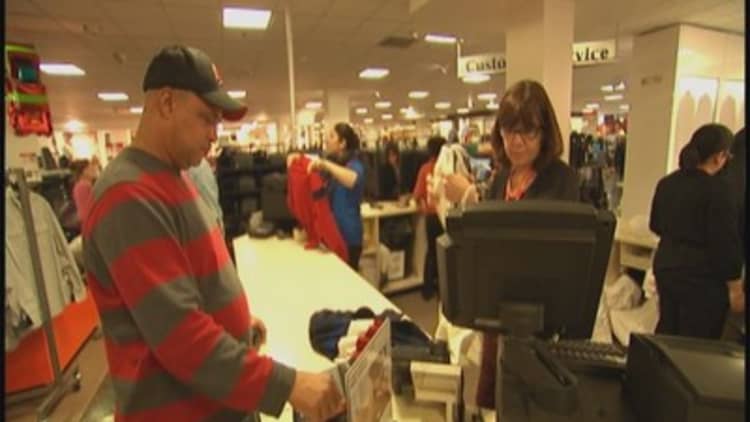
While markets celebrate the best quarterly GDP growth in 11 years, economists are ratcheting up their fourth-quarter growth forecasts but to a somewhat slower pace than the third quarter.
The economy roared ahead in third quarter, growing at 5 percent, with a big boost from the consumer. That comes on top of 4.6 percent GDP growth in the second quarter, which was a big bounce back from the first quarter's weather-related decline of 2.1 percent.
The CNBC/Moody's Analytics rapid update of economists' GDP forecasts shows a median expectation of 3 percent growth for the fourth quarter, and a range of expectations from 2.2 to 4.2 percent.
"I'm looking for 2.7 to 3 percent (fourth quarter), which means we'll have a 3 percent year here," said Mesirow Financial's chief economist, Diane Swonk. "This is the strongest year since 2005. We keep waiting for 3 percent. It looks like we got it." Swonk said this could be the first time in nine years that growth was 3 percent fourth quarter to fourth quarter.
Read MoreHow to play third-quarter GDP beat
Swonk and other economists, however, are also eyeing signs of weakness, particularly in business spending. "We take the celebration one step at a time," she said. "I expect the first quarter to be a little bit weaker."
The final read on third-quarter GDP was much stronger than the 4.3 percent growth that was expected. The data came at the same time a report on durable goods for November showed new orders declining 0.7 percent when economists expected an increase.
"The downside is the chill in business," Swonk said.
Ward McCarthy, chief financial economist at Jefferies, is more optimistic for the fourth quarter than some economists, and he expects growth of 4 percent. But he too is watching capital spending and will revise his forecast if business spending continues to look weak.
Read More
"The durables numbers were a little bit troubling. A lot of the weakness was defense," he said. "We've seen core orders which is a good proxy for capex decelerate significantly over the last couple of months. ... It suggests maybe we should be a little bit less optimistic about capex going forward. But these numbers are notorious for being the most volatile of the economic data releases."
JPMorgan economists expect fourth-quarter growth of just 2.5 percent, and they note improved consumer spending in November offset the weakness in durables. "As a result, we are still tracking 2.5 percent GDP growth in Q4, albeit with more consumer spending and less capital spending than in our prior projection."
The economists point out that a November gain of 0.7 percent in real consumer spending, reported Tuesday, was the strongest monthly gain since the cash-for-clunkers stimulus program in August 2009. Personal income rose 0.4 percent.
In third-quarter GDP, consumption was revised higher to 3.2 percent. Most of that 1 percent revision came from consumer service spending, particularly health-care spending.
Deutsche Bank's chief U.S. economist, Joseph LaVorgna, said the pickup in services spending is important. "That matters. If you look at this business cycle. It's the only cycle where services spending went negative, and part of that was health care." He said if it continues, it could lift consumption to a sustained 3.5 to 4 percent pace.
LaVorgna expects another 4 percent-plus quarter. "I wouldn't rule out 5 percent in Q4. We haven't fully benefited from the oil collapse," he said. "Unless you were an energy producer which is only about 9 percent of total business, the other 91 percent of businesses got a tax cut."
Swonk said the drop in oil prices is proving to be good news for consumers, but what's not clear is how slower U.S. energy production growth could ripple through the economy. "What's really going to be critical is how do lower oil prices affect the low-hanging fruit, things like pickup truck sales," she said.
Read More
LaVorgna said there's a major component of the economy that has not been delivering its share and the economy is still strong. "What's remarkable is we did it without housing. That has yet still to contribute. That to me is what gets me bullish, looking out next year and beyond," he said.

